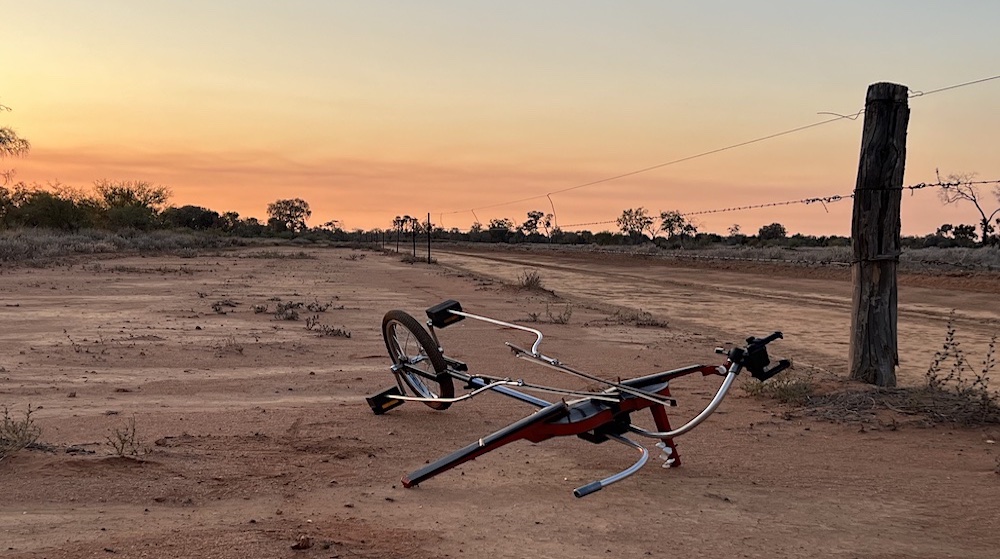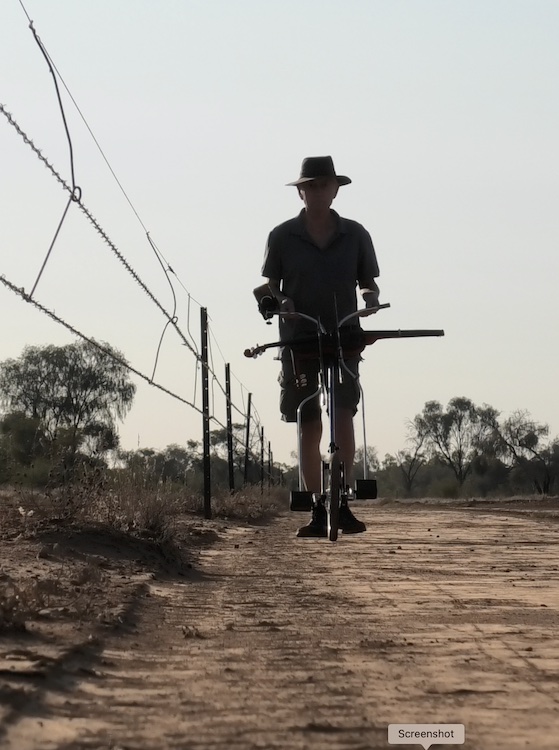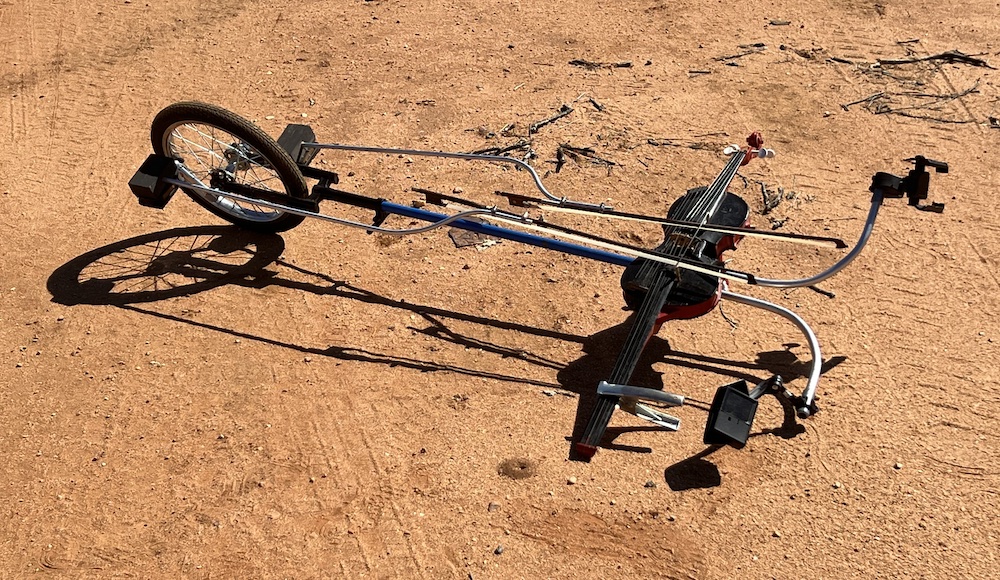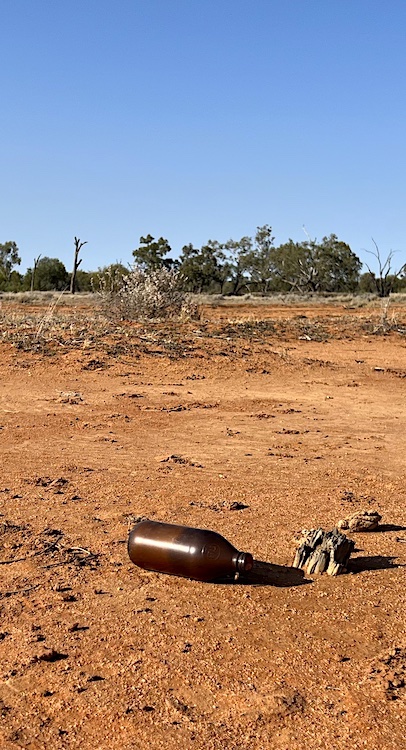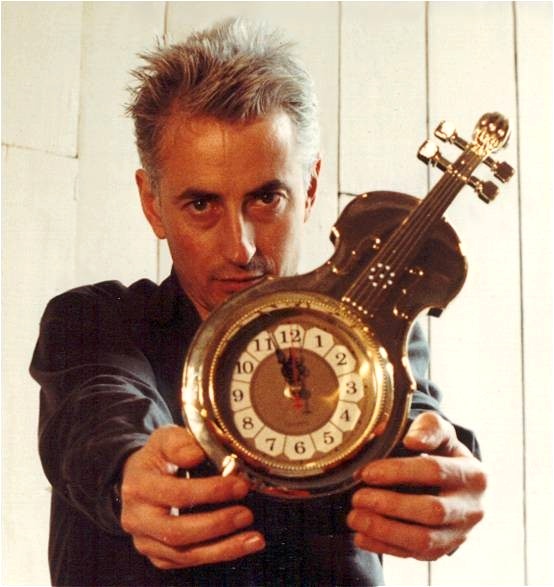mapping
exploratory music with the wheeling violin
The video Mapping, featuring the triple neck, double piston, wheeling violin on location around Alice Springs/Mparntwe by Jon Rose is available here.
Turn audio on/off - Mapping the terrain with transmitted interactive software mounted on the wheeling violin.
Mapping the terrain of Central Australia
On resurrecting the 41 year old triple neck, double piston, wheeling violin, I continued my exploration of Australian terrain, this time in Central Australia. The first materialization of the instrument required the performer to both hold and play the main violin necks.
I decided to add handle bars and let the open strings ring (unstopped by fingers) in various scordatura options, modifying the basic arpeggio bow action, going for two ‘broken’ 8 note chords instead. A bigger and better sound. Then I thought, why not add some interactive gear to the set up? So experiments ensued with an Arduino box attached to either handle bars, the bows, or wheel, and data transmitted to a nearby computer (up to 150 meters away). I also used timers augmented by this live data, which was sonically speaking more useful than unmediated data transfer. (One timer works in 3 time another in 5, which immediately makes the basic 2/2 nature of the instrument more compelling). The topography (bumps, gradients, side slips) of the terrain interrupts and varies the cyclic motion of the wheel. The interactive sounds heard all originate from the instrument.
Some musicians have already tested the physical durability of the piano in Australian conditions, and I have exposed the violin to water, wind, fire, explosives, the freeway, and the full horrors of the supermarket. But the level of topographical detail proposed in Mapping has required months of trial and error, always keeping in focus the exacting interface between the physical (land) and the iconic (musical instrument), and avoiding any semblance of cultural imperialism and colonial conquest (we continue to suffer the results of that). The repairs necessary on the violin after every outing proves the environment wins every time, and my ecological ‘footprints’ are ‘disappeared’ soon enough.
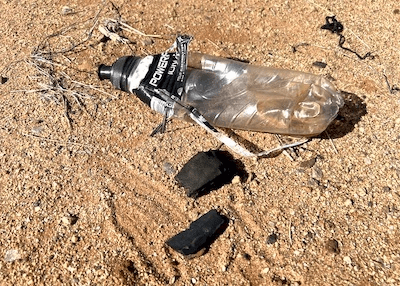 Walking a wheeling double piston violin fits our bipedal nature perfectly with the physical presence from the road, track, or salt lake, framing the music - a music determined by distance as much as time.
Walking a wheeling double piston violin fits our bipedal nature perfectly with the physical presence from the road, track, or salt lake, framing the music - a music determined by distance as much as time.
And then there is the desert detritus that our species spews out on their travels that might well end up as significant, from an archaeological point on view, once we are all extinct. Non human animals generate many tracks - and you will see the light steps of kangaroos, wallabies, possums, dingos, etc along with our markings of ownership...although I’ve never found tyre tracks so mesmerizing!
Strings: After four decades, I was reluctant to change them as entropy and decay appeal to my thinking. However I did prepare them sometimes with clothes pegs, and following various scordatura trials, I ended up with four strings creating eight almost identical pitches...then I removed all the strings, leaving just the sound of the bow hairs articulating a 2 stroke asthmatic wheeze in the breeze. The sympathetic strings, as well as being plucked, performed their expected resonating function. The occasional clonks are caused by the wood of the bows hitting the retaining bar on bumpy stretches of the journey.
There were three locations selected - part of the road to Ltyentye Apurte (Santa Teresa) which I have named Hoon Alley, the Ilparpa Clay Pans, and a track near Yeperenye National Park.
If I were a minimalist performance artist, I would have just bolted a camera onto the wheeling violin and headed off down the road until the batteries ran out, I was hit by a truck, or the 40 year old plus home made instrument fell apart. But (to quote composer Tom Johnson on my work) I’m a maximalist musician. Enjoy the ride.
Jon Rose © 2023












